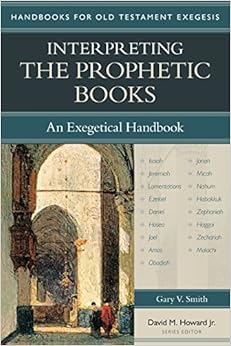 When I finish our current series on the Gospel of Mark, I’ll be looking for the next book to walk through. I doubt the first thing that comes to my mind will be one of the prophets. Though I’ve preached an overview of the Minor Prophets, I’ve never actually preached through one of the major prophets. They are tough to read and that much more difficult to actually preach.
When I finish our current series on the Gospel of Mark, I’ll be looking for the next book to walk through. I doubt the first thing that comes to my mind will be one of the prophets. Though I’ve preached an overview of the Minor Prophets, I’ve never actually preached through one of the major prophets. They are tough to read and that much more difficult to actually preach.
Gary Smith has written Interpreting the Prophetic Books in the hopes that seminary students and pastors (like myself) will quit being chickens and get equipped to preach through one of the prophets. The book belongs to a series of other handbooks for doing Old Testament exegesis. These are written for pastors and seminary students to learn how to do exegetical work. As such they feel a bit like a text book for an introductory class.
I appreciate much of Smith’s work in this handbook. It will serve as a helpful introduction to many students. Having a brief section at the beginning of each chapter which outlines the chapter, and providing a helpful glossary in the back, makes this book a great tool for weary pastors or bogged down seminary students. Providing a chapter on themes and summaries for each prophet will also be helpful for the pastor who wants to begin tackling one of these prophetic books. He also provides a handy list of helpful commentaries for each of the prophets. Little jewels like this will make this a valuable resource for a pastor to consult before diving into his new sermon series.
Smith’s fourth chapter on interpretive issues is also a helpful addition to the book. Here he asks some key questions about how we ought to read the prophets. Knowing when something is literal or metaphorical, conditional or unconditional, near or far future, is critical in properly interpreting and preaching a prophetic passage. Smith gives a solid outline for answering these questions. He also introduces the reader to a few options in thinking about a passages New Testament fulfillment.
In the area of New Testament fulfillment, though, is where I believe this book is lacking. I appreciate much of Smith’s work in chapters 5 and 6 in helping preachers put together the text in a way that is manageable. This will help the preacher to preach clearly. But, I don’t know that it will help the preacher to do so Christo-centrically. If the student wants a few helpful pointer for how to build a bridge between the prophetic text and the Cross he will be found wanting.
For those of us who believe OT preaching ought to be Christ-centered, this is a glaring omission. If one is in the school of thought of someone like Walt Kaiser, who doesn’t care much for the way we do Christ-centered preaching, then I think you’ll find a faithful friend in this little handbook. But for one, like myself, who believes in OT Christ-centered preaching you’ll want to supplement this book with another resource.
This is a great resource for understanding the prophets in their original context. It is even a good resource for preparing the preacher to preach from the OT prophets. But it falls short in equipping pastors to preach Christ from the prophets. It’s a good resource but, in my opinion, it is incomplete. It really would be an asset to the preachers library
You can buy it here.